
How Zapier helped us increase revenue by $350,000
We have a sales rep on my team that used to spend 15+ hours every week following up with leads. Now? She spends around three hours, which means more time on the phone making sales.
How? We automated parts of her job. Primarily an advanced sales follow-up, and other automations, which we set up with a platform called Zapier. In fact, we can trace back $350,000 in revenue to tasks we automated.
If you are a solopreneur, leveraging Zapier automations helps you get more done in less time, so you can focus on higher value activities. If you have a team, even a small one, these benefits are magnified: Zapier makes your people more productive and you can build systems that are faster, more reliable, and more standardized than human effort.
It’s the approach we use at Museum Hack. We are a bootstrapped, renegade museum tour company that did $600K in sales in 2014, and $2.7 million in 2017; we are growing fast. 💪
Now, let me show you how we’ve made Museum Hack a lean, mean, automated machine.
Zapier: The automation super platform
Zapier is an online automation platform that connects apps like Gmail, Slack, MailChimp, Twitter, Facebook, WordPress, Stripe, and thousands more. You start with a “trigger,” like “new article on my blog,” and connect it to one or more actions, like “post the link to Twitter” or “add it to a draft campaign in MailChimp.” These combos of trigger and actions are called “Zaps.” Zapier has a “forever free” tier and is user-friendly; no coding skills required.
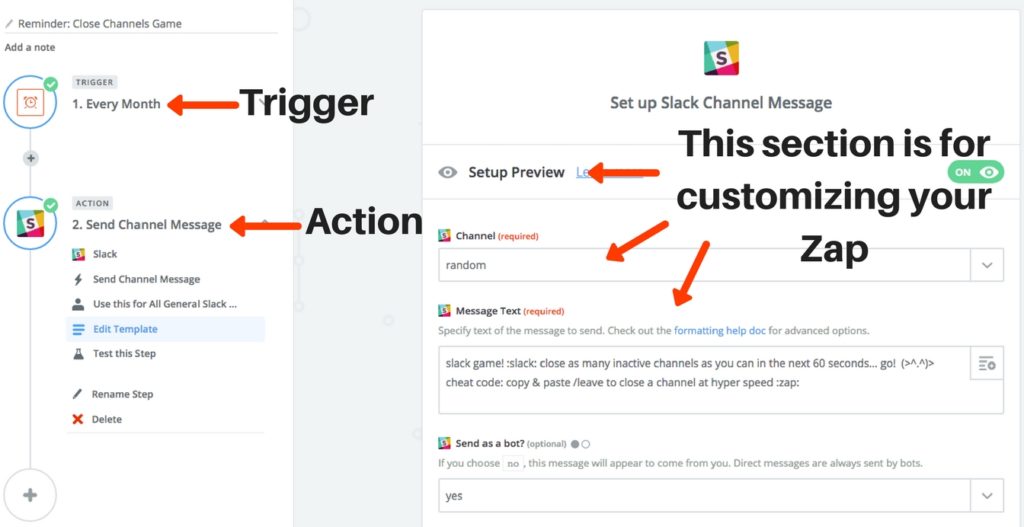
The following sections include specific examples of Museum Hack’s automated systems (called “Zaps”), built on Zapier, plus a few more from other successful companies, organized by sophistication level.
Beginner Zaps
Intermediate Zaps
Advanced Zaps
Ninja-level Zaps ✨
Want to build a business that enables you to live YOUR Rich Life? Get my FREE guide on finding your first profitable idea.
Beginner Zaps
Beginner Zaps connect two points: a trigger and an action. These zaps are useful for tasks that are always completed the same way, and may not have a high enough ROI to invest labor in.
Content marketing
Articles on Museum Hack’s main site see 50,000+ views per month, and that number is on the rise. A lot of our traffic comes from social media.
If you are solo or with a small team, spending 10+ minutes to post on Facebook, Twitter, or LinkedIn is likely worth it to get more social shares. Other platforms may be less relevant to you, but still a potential source of traffic. Unless you expect to see great returns, you can automate Pinterest.
At Museum Hack, the Pinterest automation looks like this:
Trigger: [publish new article in category “stories” on WordPress] -> Action: [post image, title, and URL to Pinterest]
And the output is this:

This Zap makes sure that every “story” we publish on the Museum Hack blog also posts to our Pinterest account. It’s still TBD on whether Pinterest will become a meaningful source of traffic for us, but for now it contributes additional readers to our articles with no additional maintenance.
Email marketing
Zapier is a great way to supercharge your email marketing. Neil Patel, a well-known marketer, uses a Zap for this purpose:
“I love to automate Facebook Lead Ads with Zapier because it allows me to send those leads directly to a pre-established email campaign!
I don’t have to download my leads from Facebook, format the file, upload it into MailChimp, create a new campaign, and then monitor it.
Instead, I can set up a ‘Zap’ using Zapier to do all of this automatically.” – Neil Patel

With Neil’s Zap, he skips the work of getting Facebook Ad Leads to his email list, it just happens.
Data sourcing
Zapier can monitor massive amounts of information and save bits that are relevant to you. Noah Kagan, founder of Sumo, uses Zapier for this purpose:
“Zapier allows you to send new data from almost ANY tool into Google Sheets as a new row,” he writes. “My two favorite Zaps: Save Twitter Mentions to a Google Sheet & New MailChimp Subscribers to a Google Sheet.”
By tracking all Twitter mentions, Noah has instant access to a list of users that have engaged with him. This data is useful, for example, when Noah publishes an article or promotion; he can ask these users to share the message.

In many cases, Beginner Zaps are not “home runs” but base hits; they will save you seconds or minutes, which add up to hours and days over time.
Intermediate Zaps
Intermediate Zaps connect three or more points: either a trigger plus two actions or a trigger plus a filter and an action. These Zaps are useful for tasks that otherwise have some degree of simple judgment or decision making.
Reporting
Every metric we’ve tracked at Museum Hack has improved over time, whether it is email sign-ups, page views, leads, or sales.
Here’s a Zap that helps us with reporting:
When a new lead is added to our CRM, Base, that lead is counted and added to a list. Every Friday at 1 p.m., Zapier automatically emails this list to a Slack channel with the subject “This Week in Leads: [# of leads].”
This Zap gives a quick report to our marketing and sales teams, who then know roughly how many leads came in so they can adjust their work efforts as required. The report can also flag issues, like if leads suddenly drop.
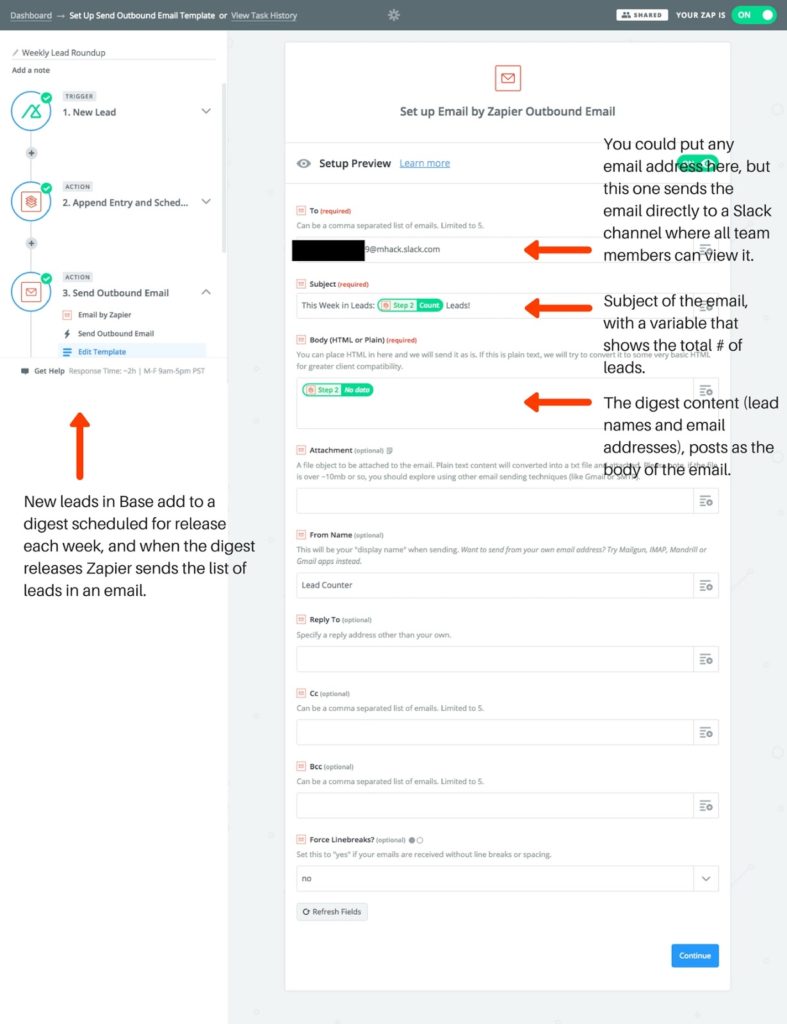
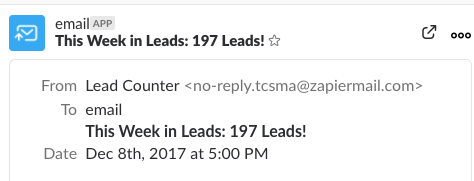
Email marketing
Our sub-brand, Museum.Jobs, is a free job postings site for museum professionals. Museum.Jobs has its own email list of 9,000+ people, who we send job notifications to.
Every Monday, Zapier checks the site for new job postings. If there are three or more new jobs, Zapier collects these into a list and creates a fully formatted campaign in MailChimp. The subscribers get what they want (job notifications) and fulfilling this want takes zero maintenance.
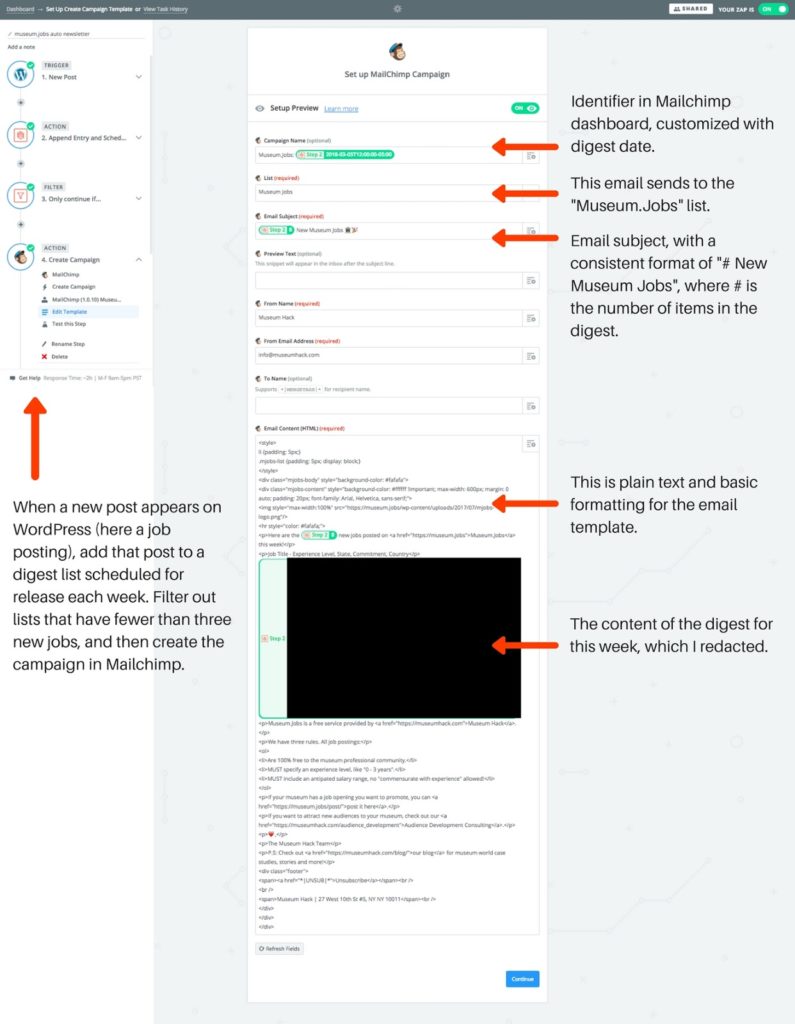
Intermediate Zaps can make significant contributions to your business, ranging from time savings, to improving existing processes, to helping you generate more revenue. Then you can get more advanced.
Advanced Zaps
Advanced Zaps connect as many triggers, filters, and actions as necessary to replace a business function. These Zaps are useful for building systems that allow your business to scale.
Content creation
Museum Hack publishes case studies of innovative people and museums. By standardizing and automating this content creation, we can produce more of it more regularly.
Here’s how it works:
First, a user fills out a Google Form. The form includes fields for the user’s name and contact information, plus five standard questions with examples of great answers, and an image upload. All of the fields are required.
When the user submits the form, Zapier sends their inputs to WordPress, which automatically creates a new draft post with the content including HTML formatting, a title, and featured image.
Then, Zapier sends a message to Slack that a draft is ready to review and schedule. We could just push the post live, but we prefer to add the element of human quality control.
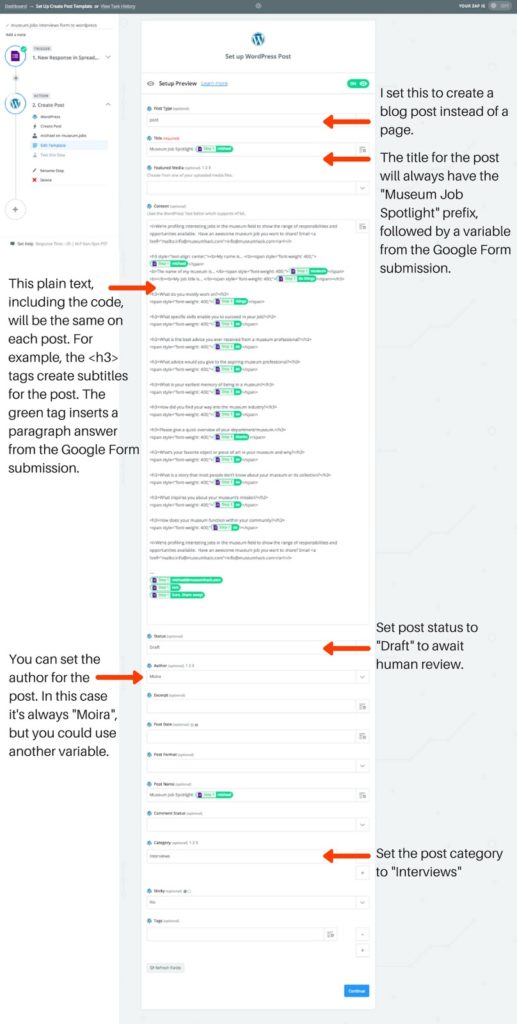
SaaS replacement
About a year ago, we started using Zapier to replace software subscriptions (and therefore, the per user fee for 60+ people). Zapier has a flat monthly fee, regardless of the number of users, so the result is we’ve saved money AND built a more streamlined organization.
Here’s an example. Previously, we used Performance Management Software at a cost of $6,000+ per year. This tool had a few useful features, including weekly check-ins where a team member answers questions like “what are you working on?”, “is there anything your manager can help with?”, and “how are you feeling?”
Here’s how our Zapier substitute works:
Every Friday at 3 p.m., Zapier posts a reminder to Slack, “complete your weekly check-in! 😊 [link]” You could also send this notification by email.
The team member fills out a Google Form, which includes the relevant questions.
Zapier sends the team member’s answers to their manager via Slack for immediate review, as well as to a Google Sheet to keep a historical record.
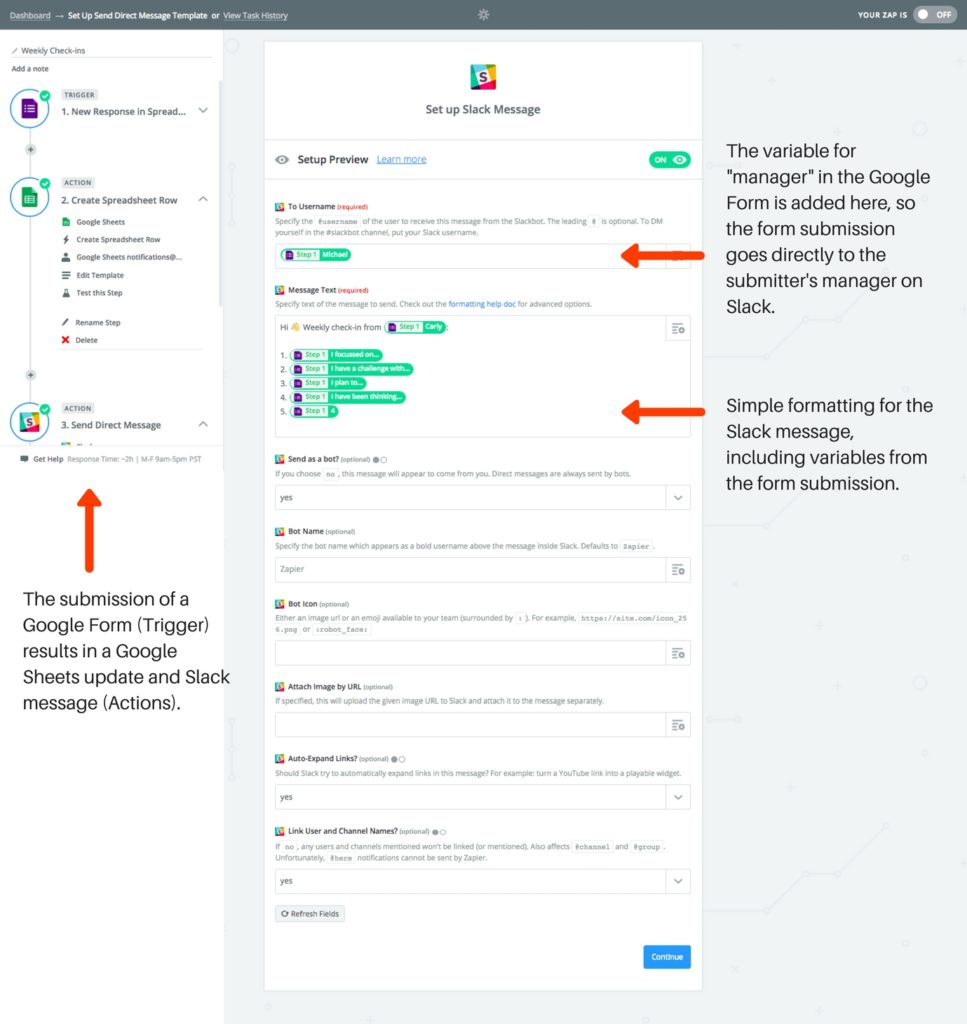
This example is just one case of software we’ve substituted with Zapier, saving $6,000+ per year. You can do the same for project management, hiring, email, and many other tools. Note: in many cases dedicated software is a good investment for your business. The goal is to optimize spending and results, not to cut it out completely.
Advanced Zaps have the power to unlock significant gains for your business and give you an edge over the competition.
Ninja-level Zaps ✨
Ninja-level Zaps connect triggers, filters, actions, and possibly custom coding to build something AWESOME, often in a novel way. These Zaps can do more than just replace existing business functions; you can also unlock the highest levels of performance.
Sales automation
In a short period, Museum Hack increased our high value corporate leads from ~30 per month to 300+, which took revenue from ~$600K in 2014 to ~$1.2 million in 2015. Continued growth in leads quantity and quality, plus other systems, helped us reach $2.2 million in 2016 and $2.7 million in 2017.
Our success came with growing pains: our sales team focused on fresh new leads as they came in, so some of “yesterday’s leads” would fall through the cracks. We hired more sales reps, and also set up a Zap that has drastically improved our sales process.
Here’s where the $350,000+ revenue gain I mentioned in the intro comes into play:
Prior to Zapier, we would have qualified 2,538 leads per year, and now we qualify 3,487. Our close rate is also changing over time, but assuming 20%, this means 189 additional qualified leads convert to deals each year. Our sales range from $599 to $40,000, with an average deal value of $2,050. The total annual revenue gain from this one system is $387,450.
Here’s how it works…
Every new lead in our CRM, Base, is also added to a Google Sheet via a Zap. We add the lead’s name, email address, and company.
When a sales rep moves a lead in Base from the stage “new” to “automated follow-up,” it triggers a Zap. This Zap finds the corresponding row in the Google Sheet and then updates that row with the sales rep’s name and email address, and a cell that turns the machine on by adding an “x.”
Another Zap watches for cells that change to “x”, which triggers a series of customized emails to the lead. Previously, Zapier sent these emails via a Gmail integration, but now we send them via Active Campaign because it has superior analytics.
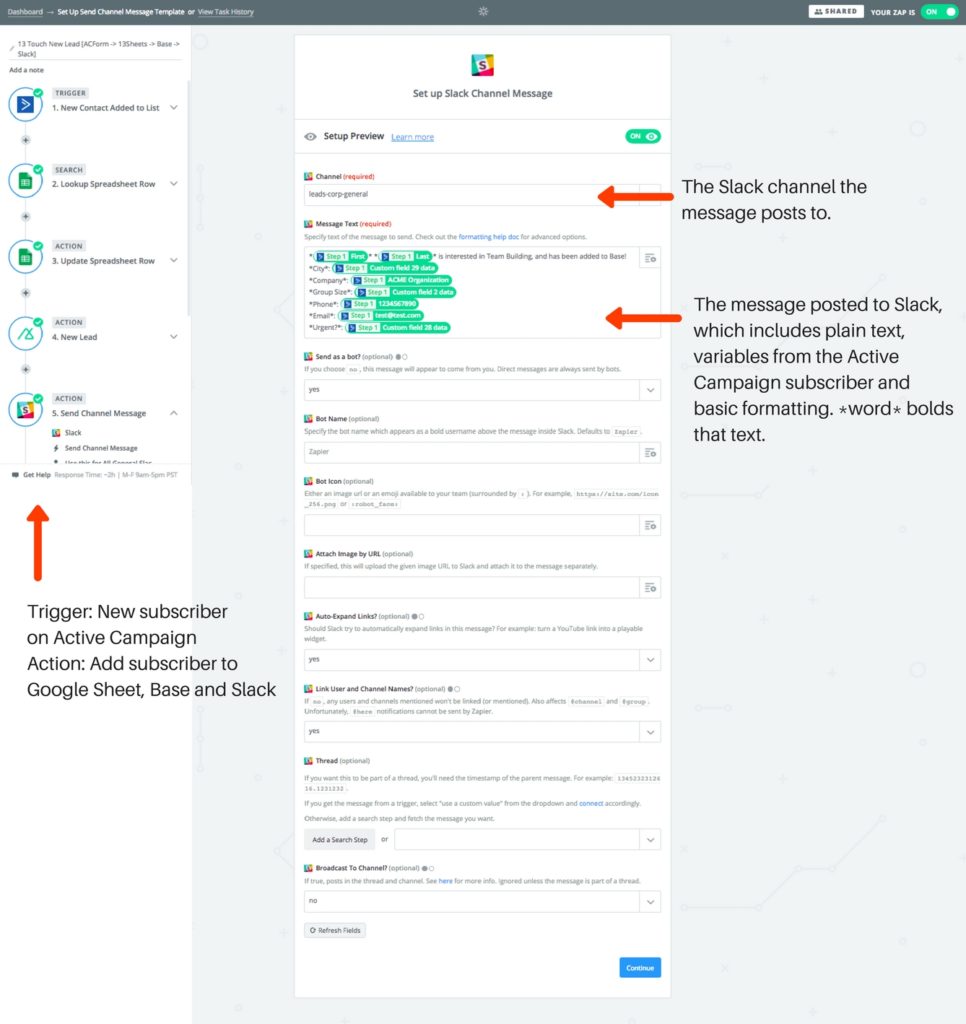
Again, this system is powering another $387,450+ in revenue per year, in addition to hundreds of hours of saved time for our sales reps. Because this Zap increases a powerful lever, lead qualification rate, the associated gains should increase as we increase leads or improve our close rate.
That’s the kind of growth you can unlock with Zapier.
Conclusion: Automation is a powerful lever for business growth
Zapier is a powerful platform that can automate a wide variety of processes in your business. You will save time, you can save money, and you can build growth systems that help you reach $1 million and beyond.
Do you have a favorite Zap? Or an idea for one you want to create? Leave a comment below. I’ll be happy to share my thoughts on it.
Want to build a business that enables you to live YOUR Rich Life? Get my FREE guide on finding your first profitable idea.
Host of Netflix’s “How To Get Rich” NYT Bestselling Author, & Host of the I Will Teach You To Be Rich Podcast. I’ll show you how to take control of your money with my proven strategies so you can live your RICH LIFE.
Written by Ramit Sethi
Host of Netflix’s “How To Get Rich” NYT Bestselling Author, & Host of the I Will Teach You To Be Rich Podcast. I’ll show you how to take control of your money with my proven strategies so you can live your RICH LIFE.



